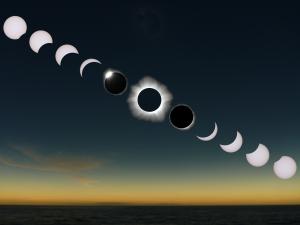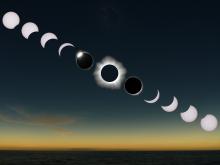Ready for the Eclipse [1]
For millions of skywatchers in the United States tomorrow, day will briefly turn to night as the Moon passes in front of the Sun, eclipsing its light [3]. The Sun’s outer atmosphere, the corona, will shine silvery-white around the dark Moon. And the stars and planets will shine through the dark as well.
Regulus, the heart of the lion, will perch closest to the Moon. It’s usually lost from view at this time of year as the Sun crosses Leo’s borders. The planet Mercury will shine brightly a little farther away, with reddish Mars on the other side of the Sun.
Brilliant Venus and Jupiter will be farther from the Sun, with Sirius, the brightest star in the night sky, low in the southwest.
You may be tempted to shoot pictures and videos throughout the show. But a total solar eclipse is a once-in-a-lifetime experience, so most veterans say it’s best to simply drink in the spectacle. And it’s one that involves most of your senses — the air will get cooler, and you’ll hear the sounds of birds and other animals preparing for night.
There are a few safety tips to keep in mind. It’s completely safe to look at the Sun when it’s fully eclipsed, but not at other times; it’s so bright that it can damage your eyes. And highway patrols around the country remind drivers not to stop on busy highways. Instead, find a park or some other safe spot to enjoy the sights and sounds of this amazing lightshow.
We’ll have more about this skywatching spectacle tomorrow.
Script by Damond Benningfield
More information about the eclipse:



